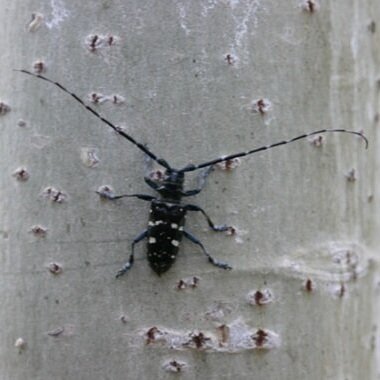
Have you seen me?
There are invasive forest pests in neighboring regions we don’t want spreading to Maine. The easiest way to reduce the spread is to not move firewood. Help protect our forests by reporting sightings to the Maine Department of Agriculture, Conservation & Forestry Bug Watch program.
NEW IN MAINE
Beech leaf disease is in multiple locations around the state, help report new sightings.
Beech Leaf Disease
Beech Leaf Disease (BLD) can impact all beech trees, even Asian and European species.
BLD can look like unusually small leaves, dark striping between leaf veins, distorted or curled leaves, and a thinning canopy.
A single beech tree can exhibit several signs of beech leaf disease, with some parts of the canopy heavily infected while other portions are healthy.
NOT KNOWN TO BE IN MAINE
Male Asian Longhorned Beetle have longer antennae than the females.
Asian Longhorned Beetle
Asian Longhorned Beetle (ALB) targets healthy hardwoods like maple, birch, elm, poplar, willow, and horsechestnut.
Key signs of ALB include discolored leaves and branch die back during the growing season and the chewed egg sites on the bark.
NOT KNOWN TO BE IN MAINE
Spotted Lanternfly has multiple life stages to look for on plants, vehicles, and other items.
Spotted Lanternfly
The Spotted Lanternfly (SLF) nymphs and adults pierce the wood to feed on the sap.
The damage from their feeding causes the wound to ooze more sap which leads to sooty mold developing on the plant.
SLF has over 115 host plants it feeds on including hardwood trees and woody crops like apple, cherry, grape, hops, maple, plum, walnut, and more.
NOT KNOWN TO BE IN MAINE
Oak Wilt makes a tree look and act like it’s fall - leaves turn brown and drop during spring and summer.
Oak Wilt
Oak Wilt is a fungus that targets all oak species and harms the tree by preventing water from properly moving within the tree.
Once an oak tree has Oak Wilt, it may show signs of leaf discoloration, wilting, tree leaves browning and suddenly dropping in the summertime, and bark splitting from the fungal pad before dying.
The symptoms of Oak Wilt are highly variable, so it is extremely helpful to know and look for multiple signs on a tree.




